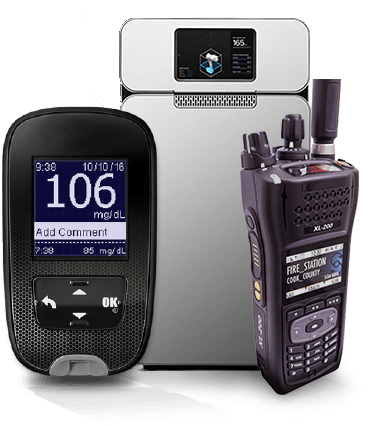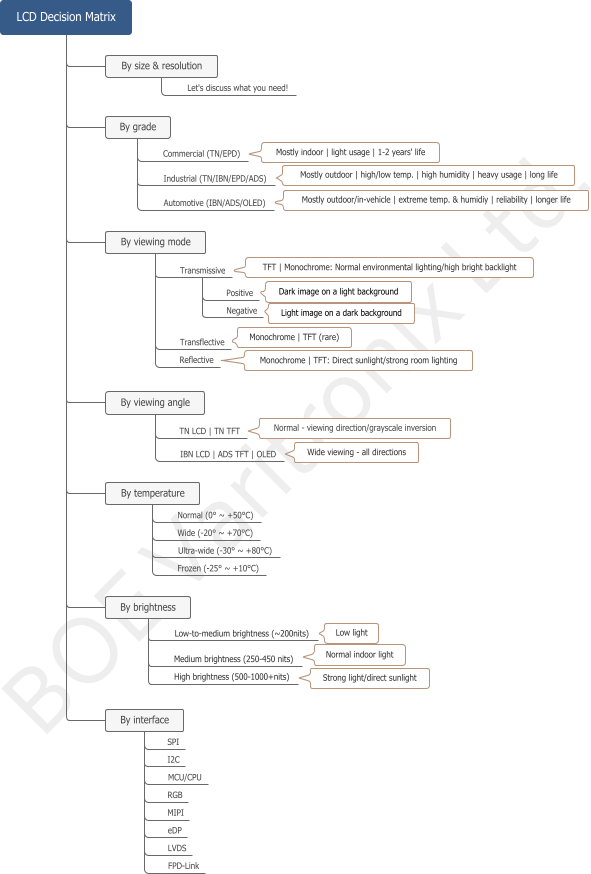
Technologies

An introductory guide to Liquid Crystal Display Selection
To find a good match of LCD for your application, here are some questions you may consider asking yourself (or us!):
Size and resolution are the two top parameters to decide on at the very beginning of a selection process. And the resolution is also related to the aspect ratio.
As we see a trend for more widescreen displays in the market, products with related sizes and resolutions are available with more varieties as well
Most LCDs in the market can be divided to three categories: 1) Consumer grade; 2) Commercial/industrial grade; 3) Automotive/marine/aviation grade.
Consumer-grade products usually have a shorter lifetime and are designed for use under normal conditions, while commercial/industrial grade displays can achieve higher reliability and rigidity in tough environments and/or under heavy usage. Sample industrial applications include portable devices for fieldwork and control panels for industrial systems and room climate, etc.
For automotive/marine/aviation products, both environmental reliability and optical performance need to be the top of their class, featuring high brightness, extreme operating and storage temperatures, ultrawide viewing angles. They are usually highly customized to meet innovative design requirements and strict quality standards.
Check out our products at commercial, industrial, and automotive grades.
| Viewing Mode | Display Description | Application Comments | Direct Sunlight | Office Light | Very Low Light |
| Reflective (Positive) | Dark images on a light background | No backlighting. Gives the best contrast and environmental stability | Excellent | Very good | Unusable |
| Transflective (Positive) | Dark images on a gray background | Can be viewed with both ambient light and backlighting | Excellent (no backlight) | Good (no backlight) | Very Good (backlight) |
| Transflective (Negative)* | Light gray images on dark background | Requires high ambient light or backlighting | Good (no backlight) | Fair (no backlight) | Very Good (backlight) |
| Transmissive (Negative) | Backlight images on dark background | Cannot be viewed by reflection | Poor (backlight) | Good (backlight) | Excellent (backlight) |
| Transmissive (Positive)* | Dark images on a backlight background | Good for very low-light conditions | Poor (backlight) | Good (backlight) | Excellent (backlight) |
1Microchip. LCD Fundamentals and LCD Driver Module of 8-bit PIC Microcontrollers. http://ww1.microchip.com/downloads/en/Appnotes/AN658-LCD-Fundamentals-and-the-LCD-Driver-Module-of-8-Bit-PIC-MCUs-00000658C.pdf
Viewing angle is the angle at which the contrast ratio is greater than 10. Display viewings are determined for the horizontal or 3, 9 o’clock direction and the vertical or 6, 12 o’clock direction with respect to the optical axis which is normal to the LCD surface.
Viewing angles are majorly determined by LCD panel type based on switching modes.
Twisted Nematic (TN) displays usually have a certain recommended viewing direction (6 o’clock or 12 o’clock) with grayscale inversion happening on the opposite side. This phenomenon is related to the horizontal orientation of neatly arranged liquid crystals under voltage.
On the contrary, wide viewing technologies, such as FFS/IPS TFT (our ADSDS TFT) and VA LCD (our IBN LCD), enable displays to be viewable from all directions and retains a 10:1 contrast ratio up to almost 90 degrees from the normal axis. Wide viewing is a vital factor to consider for many portable, orientation-switchable devices, as well as higher grade applications.
Learn more about switching modes for TFT and Passive LCD.
| Temp. type | Low operating temperature | High operating temperature | Display Type | Display Grade | Application |
| Normal | -10 ~ 0°C | +50 ~ +60°C | LCD, ePD | Consumer/ Commercial | Indoor |
| Wide | -20°C | +70°C | LCD | Commercial/ Industrial | Outdoor/ Industrial |
| Ultra-wide | -45 ~ -30°C | +80 ~ +85°C (TFT)/ +95°C (Mono LCD) | LCD | Automotive | Automotive |
2 “IEC.” IEC 60068-2:2020 SER | IEC Webstore. webstore.iec.ch/publication/62437.
Brightness, or luminance, is measured from the display surface in a dark room, with all pixels displaying white after lighting the backlight. It’s usually quantified in Candela per square meter (Cd/m2 or nit).
Common brightness of LCDs can be categorized into three levels:
- Low-to-medium brightness (~250nits)
- Medium brightness (300~550nits)
- High brightness (600~1000+nits)
Under relatively dim lighting conditions, ~250nits’ brightness LCD can display readable content with the benefit of low cost and power consumption. For most day-to-day indoor uses, 300~500 nits’ brightness is commonly seen in laptops, monitors, and mobile phones.
However, for outdoor or some indoor situations where the display is facing direct sunlight or strong ambient light, higher brightness and surface treatment (e.g. anti-glare/anti-reflection film) becomes necessary to improve the readability.
Most automotive-grade LCDs have very high brightness (800~1200+nits). And our industrial-grade LCDs offer high luminance options as well. Many LCD modules also have the potentials to increase brightness by customizing their backlights.
To communicate between your graphic card/memory card and the LCD, many display modules are configured with a default interface their controller IC supports. Interface protocols are usually limited by their transmission modes, and the bandwidth they can support. The display bandwidth is determined by its resolution, pixel RAM, frame rate, and the number of colors.
Common display interfaces and their LCD applications are shown in the table below.
Table of common display interfaces and applications
| Interface | Transmission | LCD Size | Display Type and Application |
| SPI | Serial | 1~2” | Small sized LCD, EPD, POLED |
| I2C | Serial | <3.5” | Small sized LCD, most CTP |
| MCU/CPU | Parallel | <3.5” | Small sized LCD and TFT |
| RGB | Parallel | 3.5~7” | Common medium sized TFT for industrial display |
| MIPI | Serial | 4.3~7” | Medium sized TFT for handheld/smart phone/tablet |
| eDP | Serial | >11” | Large, high resolution screens for PC/notebook |
| LVDS | Serial | >7” | Large sized TFT for Industrial/automotive display |
| FPD-Link | Serial | >5” | For automotive display |
Generally, SPI and MCU interfaces are used for passive-matrix LCDs and some small sized TFTs, I2C also supports capacitive touch panels in addition to the LCDs above.
RGB and LVDS are two widely used commercial/industrial interfaces for medium (3.5~7”), and large (>7”) sized TFT displays, respectively.
There are also several other interfaces prevailing in their specialized applications: 1) MIPI for mobile phones and other handheld devices; 2) eDP for laptops and tablets; and 3) FPD-Link for unified automotive connectivity.
Display Selection Decision Tree
Overwhelmed with information? No worries! We’ve prepared a decision tree below to help you navigate through the process of finding the right display for your application.
After sketching a silhouette of the display you need, feel free to check out our products and build up your RFQ carts or give us a call directly – we are here to help you!
Editor: Charis Chen


